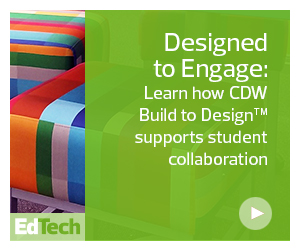Classroom Design Can Foster ‘Authentic’ Inclusion
That statement aligns with the idea that the traditional classroom setup — desks arranged in rows, facing the front of the room — is not the design most conducive to learning.
Instead, Bugaj said, classroom design can support “authentic” inclusion. Inclusion means more than serving a student who has an individualized education plan, or IEP, in a general education setting, he said.
“Is that really being included?” Bugaj asked. “Not really.”
Loudoun County schools are exploring ways to adopt flexible learning spaces districtwide. First, the district formed a task force composed of district and local administrators, support services personnel, general educators, special educators, and students to determine principles to inform the new space design.
Instruction needs to drive design, Bugaj said: “The space should be able to be transformed to the design of instruction.” Educators should strive to create flexible environments designed to give students options that meet their individual needs and can be transformed at any time.
“We know kids learn differently, they learn better, with movement and choice," says @attipscast. He offers more insight into why flexible learning spaces matter for #K12 education. #FETC #FETC2020 pic.twitter.com/jjH0Bu9rrq
— EdTech K–12 Magazine (@EdTech_K12) January 16, 2020
The design should also enhance innovation and provide opportunities to “engage and empower learning,” he said.
Education leaders can accomplish this in several ways.
Classroom design should offer “voice and choice” to foster communication, collaboration, creativity, critical thinking and contributions from students. And don’t forget about fun, Bugaj said. Students should enjoy being in the space.
Additional Ideas for Creating More Flexible Designs
Here are some other tips Bugaj shared for developing flexible learning spaces:
- Think about utility. Different parts of the space should allow options such as working independently, in small groups or as a whole group, Bugaj said. Ask what you want the end result to be.
- Find funding, whether it’s through PTAs, grants or a budget line item. In Loudoun County, the task force’s pilot rooms cost about more than twice as much as a traditional classroom with furniture. One way to save money is to seek options from multiple vendors.
- Reduce clutter and make a conscious decision about what’s used visually in the classroom. Clutter is both visual and sensory, Bugaj said, so also be mindful of noise that might be distracting or disruptive.
- Start small, transforming a few classrooms at a time. Consider beginning with furniture that serves multiple purposes, such as tables or desks with writable surfaces.
EdTech is covering FETC, so keep an eye on this page for conference coverage. Follow @EdTech_K12 on Twitter for live updates, and join the conversation at #FETC.










